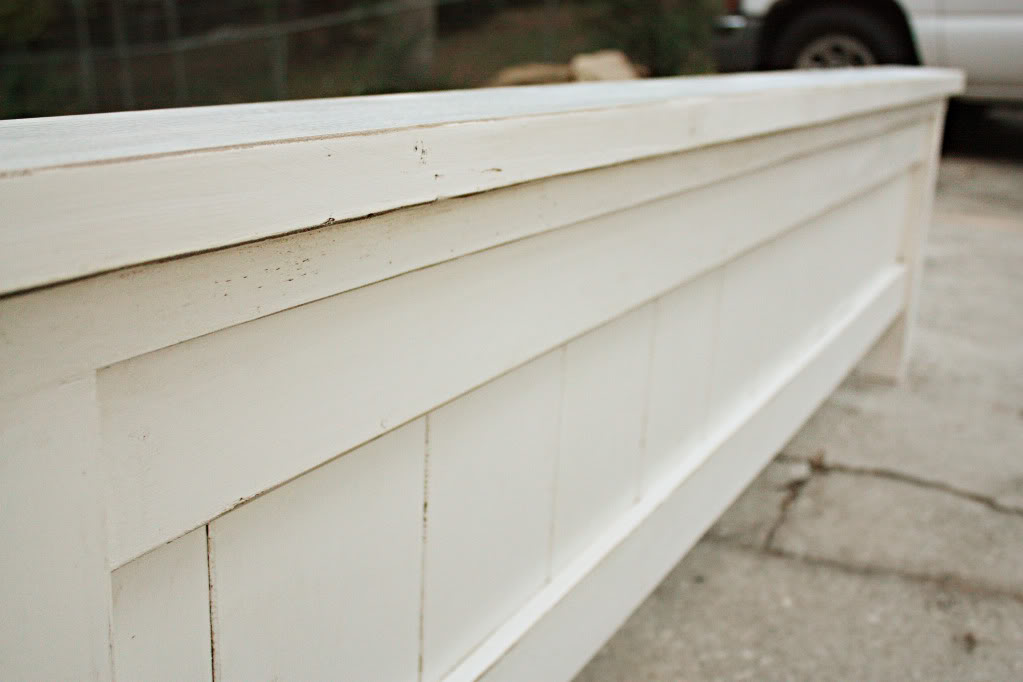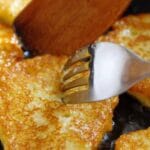White paint turning yellow on wood is a common problem that can be caused by a variety of factors. The most common reason for this is exposure to sunlight and UV rays, which causes the paint to break down and turn yellow over time.
Another reason could be the type of paint used, as oil-based paints tend to yellow faster than water-based paints. Additionally, humidity, temperature changes, and certain chemicals can also cause paint to yellow. To prevent this issue, it’s recommended to use a high-quality, water-based paint that is resistant to yellowing and to avoid exposing the painted surface to direct sunlight or harsh chemicals.

Credit: www.bowerpowerblog.com
Yellowing White Paint On Wood
The yellowing of white paint on wood can be caused by a variety of factors, including exposure to sunlight, the type of paint used, and environmental conditions. Sunlight and artificial light can slow down the yellowing process, while using oil-based paints in well-lit areas can prevent it.
Additionally, excess moisture and tobacco smoke can also contribute to the yellowing of white paint on wood.
Common Misconceptions
Contrary to popular belief, yellowing white paint on wood is not solely due to poor quality paint or improper application. There are various factors that can contribute to this issue, many of which are often overlooked.
Initial Signs Of Yellowing
One of the initial signs of yellowing white paint on wood is the development of a subtle yellow tint, especially in areas exposed to sunlight or artificial light. This can be particularly frustrating, especially when the paint was initially a pristine white.
The yellowing process can be influenced by a combination of factors, such as exposure to UV radiation, the type of paint used, and environmental conditions. Understanding these factors is crucial in preventing and addressing yellowing white paint on wood.
In many cases, a common misconception is that yellowing is solely due to the use of oil-based paints. While oil-based paints are prone to yellowing, even water-based paints can undergo this process under certain conditions. Understanding the underlying causes of yellowing and taking proactive measures can help maintain the pristine white appearance of painted wood surfaces.
Chemical Causes Behind The Yellowing
When it comes to the yellowing of white paint on wood, understanding the chemical causes behind this phenomenon is crucial. Various factors can contribute to the discoloration of white paint, and one significant aspect is the chemical reactions that take place within the paint and the wood surface.
Alkyd Resin Oxidation
Alkyd resin, commonly used in oil-based paints, undergoes a chemical process known as oxidation. This causes the resin to yellow over time, leading to the yellowing of the white paint applied on wood surfaces.
Effect Of Environmental Factors
Environmental factors such as exposure to sunlight, heat, and high humidity can accelerate the yellowing of white paint on wood. Sunlight, in particular, can trigger chemical reactions that result in the discoloration of the paint, especially when oil-based paints are used.
Environmental Influences
The yellowing of white paint on wood can be influenced by environmental factors such as exposure to sunlight, heat, and humidity. Oil-based paints are more resistant to yellowing compared to water-based paints, and using a primer can also help prevent this issue.
Additionally, avoiding exposure to tobacco smoke and placing the wood in well-lit areas can help maintain the whiteness of the paint.
Sunlight And Yellowing
One of the primary environmental influences that can cause white paint to turn yellow on wood is sunlight. Both natural sunlight and artificial light can significantly slow down or even reverse the yellowing process. To prevent white paint from turning yellow, it is recommended to use oil-based paints in rooms and areas that receive high levels of light. Oil-based paints have a higher resistance to yellowing compared to water-based paints.
Humidity’s Role In Discoloration
Humidity also plays a role in the yellowing of white paint on wood. Excessive moisture, especially in high-humidity rooms like bathrooms, can contribute to the discoloration of painted surfaces. Additionally, tobacco smoke can leave stubborn stains on doors and walls, leading to a yellowish hue. It is important to maintain proper ventilation and control humidity levels in order to minimize the impact of moisture on the paint.
In some cases, being too close to a heat source, such as a radiator or stove, can also cause white paint to yellow. The heat can accelerate the chemical reactions that lead to discoloration. Furthermore, a lack of direct sunlight can also contribute to yellowing. This may seem counterintuitive, but sunlight can actually help prevent yellowing by inhibiting the chemical processes that cause discoloration.
To remove yellow stains on white paint, using a clay bar and polish can be effective. These products can help eliminate yellowing and restore the original color. However, prevention is key to avoiding yellowing altogether. By understanding the environmental influences and taking appropriate measures, such as using oil-based paints in well-lit areas and controlling humidity levels, you can keep your white paint looking fresh and vibrant for longer.
Heat Sources And Yellowing
One of the common reasons why white paint on wood may turn yellow is the proximity to heat sources. Heat can have a significant impact on the appearance of white paint, causing it to change color over time. Understanding the relationship between heat sources and yellowing can help you prevent or address this issue effectively.
Proximity To Heat
When white paint on wood is exposed to heat, it can gradually turn yellow. This is especially true if the painted surface is located in close proximity to heat sources such as radiators, stoves, or other heating appliances. The heat emitted from these sources can cause the paint to undergo a chemical reaction, leading to discoloration.
To prevent yellowing due to heat sources, it is essential to ensure that your painted wood surfaces are not placed too close to these appliances. Maintaining a safe distance between the heat source and the painted surface can help minimize the heat’s impact and reduce the likelihood of yellowing.
Impact Of Cooking Appliances
Cooking appliances, such as stoves and ovens, can generate heat that may affect the white paint on nearby wood surfaces. The heat produced during cooking can contribute to the yellowing of paint over time. Additionally, cooking fumes and grease particles in the air can settle on the painted surface, further accelerating the yellowing process.
To prevent yellowing caused by cooking appliances, it is advisable to install proper ventilation systems in your kitchen. Good ventilation can help remove cooking fumes and prevent them from settling on the painted surfaces. Regular cleaning and maintenance of the painted wood surfaces near cooking areas can also help prevent the accumulation of grease and other substances that can contribute to yellowing.
By being mindful of the proximity to heat sources and the impact of cooking appliances, you can take proactive measures to prevent or address the yellowing of white paint on wood. This will help maintain the desired aesthetic appeal and longevity of your painted surfaces.
Lifestyle Factors
Is your white paint turning yellow on wood? There are a few lifestyle factors that could be causing this. Excessive moisture, exposure to heat and humidity, lack of direct sunlight, and even tobacco smoke can all contribute to the yellowing of white paint on wood.
To prevent this, consider using oil-based paints in well-lit areas and maintaining proper ventilation.
Smoking Indoors
Smoking indoors can be a major factor in why your white paint is turning yellow on wood. The nicotine and tar in cigarette smoke can easily stick to surfaces and cause discoloration over time. This can be especially true for walls and doors that are frequently exposed to smoke. To prevent this, it is recommended to smoke outdoors or in a designated smoking area away from painted surfaces.
Cleaning Products And Reactions
Another lifestyle factor that can cause yellowing of white paint on wood is the use of certain cleaning products. Some cleaning products contain chemicals that can react with the paint and cause discoloration. It is important to read labels carefully and avoid using harsh chemicals on painted surfaces. Instead, opt for gentle, non-abrasive cleaners that are safe for painted surfaces.
Overall, lifestyle factors such as smoking indoors and using harsh cleaning products can contribute to the yellowing of white paint on wood. It is important to be mindful of these factors and take steps to prevent discoloration. By taking care of your painted surfaces and avoiding exposure to harmful substances, you can keep your white paint looking fresh and vibrant for years to come.
Preventive Measures
Yellowing of white paint on wood can be prevented by avoiding the use of oil-based paints in areas with high levels of light. Natural and artificial light can slow down or even reverse the yellowing process. Additionally, excessive moisture, tobacco smoke, and being too close to a heat source can also cause white paint to turn yellow.
If you’ve ever painted wood with white paint, you may have noticed that over time, the paint turns yellow. This is a common problem that can be caused by a number of factors, including sunlight, humidity, and even the type of paint you use. However, there are some preventive measures you can take to help keep your white paint looking fresh and clean.
Choosing The Right Paint
One of the most important preventive measures you can take is to choose the right type of paint. Oil-based paints are more prone to yellowing than water-based paints, so if you’re painting a room that gets a lot of natural light, it’s best to use a water-based paint. Additionally, you should always use a high-quality paint that is specifically designed for wood surfaces.
Proper Application Techniques
Another important preventive measure is to use proper application techniques when painting. This includes properly preparing the surface, using the right tools, and applying the paint in thin, even coats. It’s also important to let each coat of paint dry completely before applying the next coat.
To summarize, if you want to prevent your white paint from turning yellow on wood, you should choose the right type of paint and use proper application techniques. By taking these preventive measures, you can help keep your white paint looking fresh and clean for years to come.
Solutions And Fixes
White paint turning yellow on wood can be due to a number of reasons like aging, heat, humidity, and lack of direct sunlight. To prevent yellowing, use oil-based paints in rooms with high levels of light and clean with a clay bar and polish.
Light can also slow down and even reverse the yellowing process.
Cleaning And Maintenance
Proper cleaning and maintenance can help prevent white paint from turning yellow on wood surfaces. Here are some steps you can take:
- Dust and wipe regularly: Dust and debris can accumulate on the surface of the painted wood, leading to discoloration over time. Use a soft cloth or a feather duster to remove dust and wipe the surface gently.
- Avoid harsh cleaning agents: Harsh chemicals and abrasive cleaners can damage the paint and cause it to yellow. Stick to mild cleaning solutions, such as a mixture of warm water and mild dish soap, to clean the painted wood.
- Protect from direct sunlight: Exposure to sunlight can accelerate the yellowing process. If possible, use curtains or blinds to limit the amount of direct sunlight that reaches the painted wood.
- Control humidity levels: High humidity levels can contribute to yellowing of white paint. Use a dehumidifier in rooms with high moisture levels, such as bathrooms, to prevent excessive humidity.
Repainting And Primer Selection
If your white paint has already turned yellow, repainting the wood surface can help restore its original appearance. Here are some tips:
- Scrape off the old paint: Use a paint scraper or sandpaper to remove the old yellowed paint from the wood surface. Make sure to wear protective gloves and a mask while doing this.
- Select the right primer: Choosing the right primer is crucial to prevent the yellowing of white paint. Opt for a high-quality stain-blocking primer, such as BIN Shellac-Based Primer, which can effectively seal the wood and prevent stains from bleeding through.
- Apply multiple coats: Apply two or more coats of white paint, allowing sufficient drying time between each coat. This will help ensure even coverage and a more durable finish.
- Consider water-based paints: Water-based paints are less prone to yellowing compared to oil-based paints. Consider using water-based paints, especially in areas exposed to high levels of light.
By following these cleaning and maintenance practices and using the right primer and paint, you can prevent or fix the issue of white paint turning yellow on wood surfaces. Remember to always read and follow the manufacturer’s instructions for the best results.
Professional Tips For Longevity
Discover professional tips for longevity when it comes to preventing your white paint from turning yellow on wood. Learn how to minimize the yellowing process by using oil-based paints in well-lit areas and taking measures to protect your painted surfaces from excessive moisture, heat sources, and tobacco smoke.
When it comes to keeping your white paint looking fresh and vibrant on wood surfaces, following professional tips for longevity is essential. By taking proper care of your paintwork, you can prevent it from turning yellow and maintain its pristine appearance for years to come.
Expert Advice On Paint Care
To ensure the longevity of your white paint on wood, it’s important to follow expert advice on paint care. Here are some essential tips:
- Choose high-quality paint: Selecting durable paint finishes is crucial for preventing yellowing. Opt for paints that are specifically designed for wood surfaces and have excellent coverage and resistance to discoloration.
- Prep the surface: Before painting, make sure the wood surface is clean, smooth, and free from any dirt, grease, or previous coatings. Proper preparation ensures better adhesion and helps the paint to adhere evenly.
- Apply primer: Using a high-quality primer is essential to create a stable base for the paint. Primer helps to seal the wood and prevent any tannins or stains from bleeding through and causing discoloration.
- Use light-reflective colors: Light-colored paints tend to resist yellowing better than darker shades. Opting for white or off-white hues can help minimize the effects of aging and light exposure.
- Avoid direct sunlight: Excessive exposure to sunlight can accelerate the yellowing process. Protect your painted wood surfaces by using curtains, blinds, or UV-blocking window films to reduce the amount of direct sunlight they receive.
- Keep humidity levels in check: High humidity can contribute to yellowing, especially in rooms like bathrooms or kitchens. Ensure proper ventilation and use dehumidifiers if necessary to maintain optimal humidity levels.
- Regular cleaning: Dust and dirt can accumulate on painted wood surfaces, leading to discoloration over time. Regularly clean the surfaces with a soft cloth or sponge using mild soapy water to remove any buildup and maintain the paint’s appearance.
- Monitor temperature: Extreme temperature fluctuations can affect the integrity of the paint. Avoid placing painted wood furniture near heat sources like radiators or stoves to prevent yellowing or cracking.
- Consider protective coatings: Applying a clear protective coat or varnish over the painted surface can provide an extra layer of protection against yellowing and extend the lifespan of your white paint on wood.
By following these expert tips for paint care, you can ensure the longevity of your white paint on wood surfaces. Remember to choose durable paint finishes, properly prepare the surface, and protect it from excessive sunlight and humidity. With proper care and maintenance, your white paint will stay bright and vibrant for years to come.
Understanding Product Selection
When it comes to preventing white paint from turning yellow on wood, understanding product selection is crucial. The type of paint you choose can significantly impact the longevity and appearance of your painted wood surfaces. In this section, we’ll explore the differences between water-based and oil-based paints and delve into innovative paint technologies that can help maintain the pristine whiteness of your wood surfaces.
Water-based Vs. Oil-based
Water-based paints, also known as latex paints, are popular for their low odor, quick drying time, and easy cleanup with soap and water. They are also more environmentally friendly due to their lower levels of volatile organic compounds (VOCs). However, they may not provide the same level of durability and protection as oil-based paints, especially on wood surfaces.
On the other hand, oil-based paints offer superior adhesion and durability, making them ideal for wood surfaces. They provide a hard, smooth finish that can withstand wear and tear, moisture, and temperature changes. However, they tend to yellow over time, especially when exposed to minimal light or low ventilation.
Innovative Paint Technologies
Advancements in paint technologies have led to the development of innovative formulations that aim to address the issue of yellowing in white paints. Some manufacturers now offer low-VOC oil-based paints that incorporate additives to minimize yellowing while retaining the benefits of traditional oil-based paints.
Additionally, there are water-based paints with improved formulations that mimic the durability and smooth finish of oil-based paints while resisting yellowing. These hybrid paints provide a viable alternative for those seeking the durability of oil-based paints without the risk of yellowing over time.

Credit: www.bowerpowerblog.com
Frequently Asked Questions
How To Keep White Paint From Turning Yellow?
To prevent white paint from turning yellow, use oil-based paints in well-lit areas. Natural and artificial light can slow down or reverse the yellowing process. Ensure good ventilation and avoid smoking indoors to reduce yellowing. Regular cleaning and maintenance can also help maintain the paint’s brightness.
How To Get Rid Of Yellow Stains On White Paint?
To remove yellow stains on white paint, use a clay bar and polish to eliminate discoloration. Prevent yellowing by using oil-based paints in well-lit areas and minimizing exposure to heat and humidity. Regular cleaning and maintenance can also help preserve the whiteness of the paint.
Why Are My White Painted Cabinets Turning Yellow?
White painted cabinets turn yellow due to aging and exposure to heat, humidity, and tobacco smoke. Lack of direct sunlight and using oil-based paints in well-lit areas can prevent yellowing. Using a clay bar and polish can help eliminate yellow stains.
Why Are My White Painted Doors Turning Yellow?
Excessive moisture, tobacco smoke, proximity to heat sources, and lack of direct sunlight can cause white painted doors to turn yellow. High-humidity rooms like bathrooms can contribute to moisture buildup, while smoking indoors can lead to stubborn stains. Being too close to a heat source, such as a radiator or stove, can also impact the paint color.
Additionally, a lack of direct sunlight can contribute to the yellowing process.
Why Does White Paint Turn Yellow On Wood?
Over time, the combination of sunlight exposure and certain environmental factors can cause the white paint on wood to develop a yellow tint. This is often due to the natural aging process of the paint.
Conclusion
The yellowing of white paint on wood can be attributed to several factors. One common cause is the aging process of oil-based paint, which naturally develops a yellow hue over time. Additionally, exposure to excessive moisture, heat sources, and tobacco smoke can contribute to the yellowing effect.
However, it is possible to prevent or reverse this process by using oil-based paints in well-lit areas and implementing proper cleaning and maintenance techniques. By understanding the underlying causes and taking necessary precautions, you can maintain the pristine white appearance of your painted wood surfaces.




